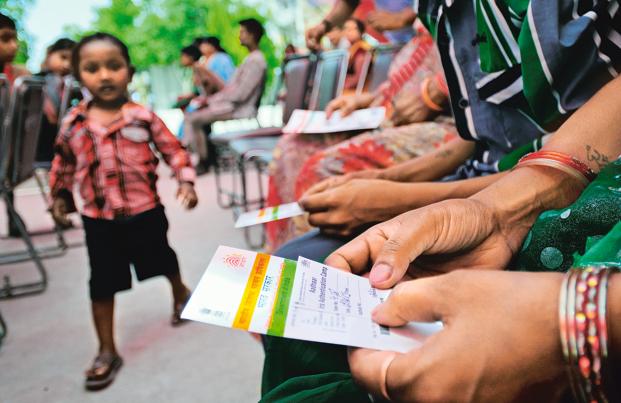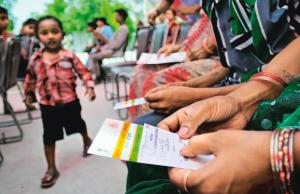Imagine being asked to submit your birth certificate to your employer by the end of the day. Most people would typically have to rummage through piles of files at home to locate it, making it a harrowing task.
The government has now come up with a Digital Locker that allows you to store such important files, and lets you authenticate them online with your Aadhaar number. It also wants to allow publishers to upload their books online so that teachers, students or guardians can choose from a combination of these books and create online satchels or e-bastas (bastais Hindi for satchel), or even download them onto an e-reader like Kindle or as portable document format (pdf) files.
These are just a few of the examples that are part of the government’s ambitious programme to make India a truly digital nation, by offering a plethora of e-governance services across sectors like healthcare, education and banking—all in a bid to introduce transparency in the system and enable inclusive growth.
The programme, which is being coordinated by the Department of Electronics and Information Technology (DeitY), was approved in August 2014 and will be implemented in phases till 2018.
To be sure, the foundations of a digital nation were laid down in bits and pieces by previous governments, especially over the last decade with the National e-Governance Plan (NeGP) approved in 2006 under the Congress regime.
But the loose ends of the vision are finally being tied up by the currentNarendra Modi-led National Democratic Alliance government that is using technologies like mobility, analytics, cloud and the Internet of Things (IoT) to implement the Digital India vision that dovetails with its other initiatives like Smart Cities (mintne.ws/1SsxYrd ) and Make in India (mintne.ws/1fIJ3GO ).
“There are three areas of Digital India—infrastructure, software and services and digital empowerment of people. Not only have we announced the Digital India vision but we also announced the concrete programmes which are to be implemented under Digital India with timelines,” R.S. Sharma, secretary, DeitY, said in an interview.
To begin with, the government introduced a number of applications and products to mark the first day of the Digital India week that began on 1 July in New Delhi. Indian businessmen followed enthusiastically by announcing investments of Rs.4.5 trillion, and hires of 1.8 million people over the next 5-10 years—though most are investments in their own businesses—as part of Digital India that is estimated to cost the government around Rs.113,000 crore.
DeitY already has a portal, MyGov (mygov.in), to facilitate collaborative and participative governance. Besides, its e-Kranti framework addresses the electronic delivery of services through 44 mission mode projects at several government departments. e-Kranti covers essential requirements of core information and communications technology (ICT) infrastructure that include the GI Cloud, data centre, network connectivity, common platforms like Aadhaar, mobile seva and a payment gateway.
Government departments have to use the GI Cloud, also known as Meghraj, to host their cloud data, and need to seek permission from DeitY if they want to do otherwise.
The focus is on designing e-governance applications so that related information, services and grievance-handling mechanisms are accessible online in real time, and across all types of access devices such as desktops and mobile devices like laptops, tablets and cellphones.
“Mobile will become a very important component in this. Everything can be done on mobile. Mobile will also become the digital identity as we link mobile to Aadhaar. And with mobile, you will be able to do transactions. This is one area where we have done substantial work,” Sharma said.
Over 1,700 government departments and agencies across the country already use the mobile platform, Mobile Seva. DeitY has also collaborated with the NSDL Database Management Ltd, a wholly-owned subsidiary ofNational Securities Depository Ltd, to provide PayGov, a centralized platform for facilitating all government departments and services to collect online payments from citizens for public services.
These include online banking and payments using debit cards, credit cards, cash cards, prepaid cards and mobile wallets.
More importantly, Digital India policy initiatives include the use of open source software and open APIs (application programming interfaces) to ensure interoperability of software across departments, collaborative application development and cloud-ready applications, all the while not getting locked in with specific vendors for software, according to Sharma.
According to Venkatesh Hariharan, director of Alchemy Business Solutions Llp, a company that focuses on open source software and Indian language computing, “politicians and bureaucrats have a clear vision of the potential of IT and this is reflected in their policies around open source and Indian language computing—two high-impact areas that were neglected earlier”.
He cited the example of MyLpg.in, a website that has been made available in 12 Indian languages apart from English. Besides, the “government is making e-Bhasha into a national mission for IT in Indian languages. Therefore, there is hope that justice will finally be done to the multilingual nature of our country through Digital India, and that government websites and apps will be available to Indians in their languages”.
Hariharan also believes that there is “strong conviction” on open source because the government’s policy “has been supported by many central government departments”.
Sharma, on his part, believes that the government programme has made much progress.
“Now we have Bharat Net (earlier known as the National Optical Fibre Network, it is governed by the department of telecom, or DoT). Besides, the digital infrastructure has components like common service centres for every panchayat. Now, all the post offices and the CSCs are being upgraded and expanded.
“In this budget, we had announced JAM (Jan Dhan, Aadhaar, mobile). We are very much ahead on that. We have nearly 1 billion mobiles in the country. We have 15.5 crore Jan Dhan accounts and we have 860 million Aadhaar cards. So, we are more or less close to achieving the three goals—that of providing a unique identity, financial inclusion and universal connectivity,” Sharma insisted.
Nevertheless, execution will remain a challenge.
“It is a programme that is to be coordinated by our department, but the implementation has to be done by all government departments, state governments and the UTs (Union territories). We have made efforts in last one year to get to all of them on board. The idea is that once all departments start using IT in a big way, the systems they create should be interoperable, standard-based, and be able to exchange data across different applications,” said another official who did not want to be named as he was not the official spokesperson.
He cited the example of the numerous versions of public distribution system (PDS) applications in states.
“Very often, there are issues in information exchange and in ensuring that the efforts are not duplicated,” the official cited above said.
To address the issue, DeitY has developed an application for PDS that states can configure and use in their own domains. “This will ensure that all the data in existing PDS applications be subsumed or migrated to the new application and all different flavours will be included in one application. That’s one approach to fast-track implementation of applications and to ensure states come onboard without losing their individuality and ownership,” the official said.
He added it will also ensure that states “don’t spend time in buying hardware and instead focus on developing applications which can be quickly implemented. And hardware is in the cloud. So states don’t have to buy their own data centres or servers etc. for hosting the application”.
The official did admit, though, that convincing the states to do so, does pose “a big challenge”.
“Some states have been proactive to come on board faster; so, they will have an advantage. Some states may take time since their back-end systems may not be ready. They may not have computer databases of their own. They may not have funds or resources,” the official said.
Analysts, though, agree that the Digital India vision will be “a game changer for India”.
Prakash C. Prabhakar, director at Deloitte in India, believes that “the demand side of digital in a country like India is a no-brainer but it is the supply side management and operating model of the proposed transformation that requires thoughtful planning and phased implementation to ensure that the impact is as immense as envisaged”.
“The entirety of the vision also dovetails aspects of other policies of the current government such as Smart Cities and Make in India. Clearly, the vision is not a short-term one. It will require considerable investments in terms of manpower, technological upgradation, skilling, digital literacy and, most importantly, a plethora of standards to be laid out and adhered to. Some of the components of Digital India, such as Digital Locker, are a first-of-its-kind in the world and would have a deep impact on the society and the processes,” concluded Jaijit Bhattacharya, partner, cities and digital innovation at consulting firm KPMG.
WHY OPEN SOURCE MAKES SENSE FOR GOVTS
lThe European Commission joined hands with Australia, New Zealand and Vietnam to enhance software solutions by sharing and reusing them. Laws on the adoption of OSS (open-source software) in e-governance were introduced by European countries like Italy and Iceland.
lThe US department of defence has a large number of applications based on OSS and has been implementing a roadmap to adopt OSS and Open Standards.
lFrance has the largest open-source market in Europe and demand for it from public agencies is high.
lChina introduced an office document format known as Uniform Office Format or Unified Office Format (UOF) in 2005 and later, RedOffice was developed based on this. It announced its OSS policy in its 11th Five Year Plan (2006–2010).
lIn India, too, many state governments have started to adopt Linux and OSS as their de facto platforms for e-governance applications deployment. Kerala uses OSS for e-governance and IT education in schools. Tamil Nadu is pursuing the implementation of OSS. Uttaranchal signed two agreements with IBM to begin a statewide e-governance and university programme initiative based on open-source technologies and open standards.
lThe West Bengal government’s IT department has chosen open-source operating systems for its ambitious e-governance programme. Among Union territories, Puducherry was among the first to adopt OSS. The Haryana government had signed a pact with Sun Microsystems to use Sun’s Open Standards-based productivity package–StarOffice 7 Office Suite across all state government departments.

